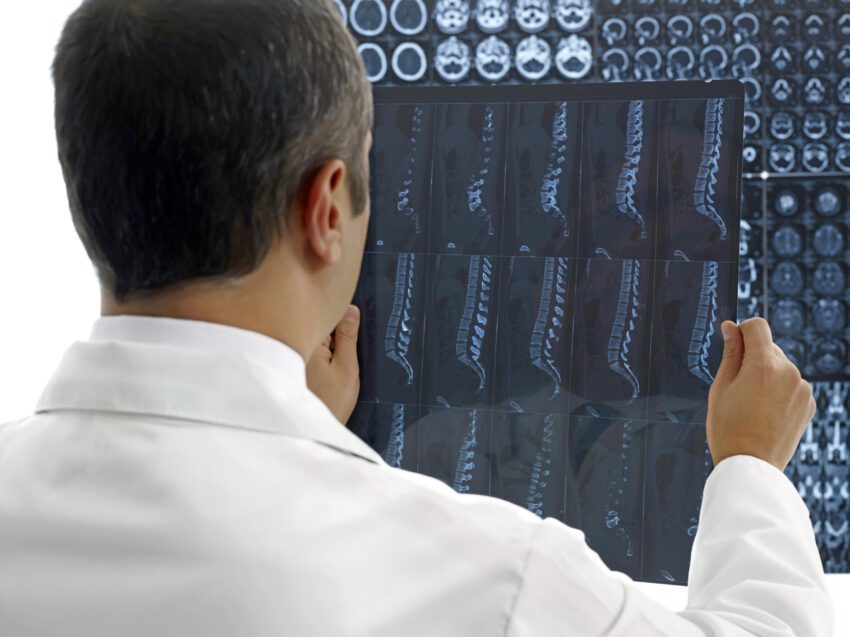A microdiscectomy (also known as microdecompression) is a minimally invasive surgical procedure used to relieve pain caused by a herniated disc pressing on a spinal nerve root. It is one of the most common and effective surgeries for treating sciatica or radiculopathy (nerve pain radiating down the leg or arm) caused by disc herniation.
Purpose of a Microdiscectomy
What It Treats
A microdiscectomy is primarily performed to treat lumbar disc herniation (in the lower back), which compresses a nearby spinal nerve, leading to leg pain, numbness, or weakness (sciatica).
Goal of a Microdiscectomy
The goal is to remove the part of the herniated disc that is pressing on the nerve root, thereby relieving nerve pain, reducing inflammation, and improving function.
Candidates for Microdiscectomy
- Ideal Candidates:
- Patients with a herniated disc causing significant leg pain (sciatica) or arm pain (cervical radiculopathy) that does not respond to conservative treatments such as physical therapy, anti-inflammatory medications, or steroid injections.
- Patients experiencing weakness, numbness, or loss of function due to nerve compression.
- Not Ideal Candidates:
- Patients with more extensive degenerative spine conditions or multiple-level spinal issues may not be good candidates for this surgery.
- Patients with spinal instability, infections, or severe spinal deformities may require more complex procedures.
Procedure Overview
Anesthesia: The surgery is performed under general anesthesia, meaning the patient is asleep during the procedure.
Surgical Approach:
- The surgeon makes a small incision (usually 1-2 inches) in the lower back, directly over the affected disc.
- Using a special microscope, the surgeon gains a magnified view of the affected area, allowing for precise work while minimizing damage to surrounding muscles and tissues.
Steps:
- Accessing the Spine: The surgeon moves the muscles surrounding the spine to access the vertebrae. Because the incision is small and the procedure is minimally invasive, the muscles are not cut, just moved aside temporarily.
- Removal of the Herniated Disc: The surgeon removes a small portion of the lamina (a part of the vertebra) to visualize the nerve and disc. Then, the part of the disc that is pressing on the nerve root is carefully removed. Only the herniated portion of the disc is removed, leaving the rest of the disc intact.
- Closing the Incision: Once the herniated disc material is removed and the pressure on the nerve is relieved, the incision is closed with a few deep sutures, then sutures, staples, steri-strips, or skin glue on the surface.
Recovery
- Hospital Stay: Microdiscectomy is typically an outpatient procedure, meaning the patient can go home the same day, though some may stay overnight for observation.
- Initial Recovery: Most patients can walk the same day after surgery, and the leg pain is often significantly reduced immediately. There may be some soreness around the incision site.
- Rehabilitation: Patients may need to avoid strenuous activities and heavy lifting for several weeks. A physical therapy program is usually recommended to strengthen the back muscles and improve flexibility.
- Return to Activities: Many patients can return to light activities within 1-2 weeks, with full recovery taking around 4-6 weeks. However, strenuous exercise or lifting should be avoided until cleared by the surgeon. This avoids the risk of a re-herniation.
Risks and Complications
Like all surgeries, microdiscectomy carries some risks, though they are generally low. These include:
- Infection: As with any surgery, there is a risk of infection at the incision site.
- Nerve Damage: There is a small risk of nerve injury, which could cause numbness or weakness.
- Recurrence: In a small percentage of cases, the disc may re-herniate, leading to a recurrence of symptoms.
- Dural Tear: During surgery, a tear in the dura (the protective layer covering the spinal cord and nerves) can occur, leading to spinal fluid leakage. This is typically repaired during surgery if it happens.
Benefits of a Microdiscectomy
- Pain Relief: Most patients experience immediate relief from leg or arm pain caused by nerve compression. The procedure specifically targets the compressed nerve, alleviating the source of the pain.
- Minimally Invasive: Since microdiscectomy involves a small incision and minimal disruption to surrounding tissues, the recovery time is quicker, and there is less postoperative pain compared to more invasive surgeries.
- Outpatient Procedure: Many patients can go home the same day, reducing the need for a long hospital stay.
- High Success Rate: Microdiscectomy has a high success rate, with many patients experiencing significant and lasting relief from their symptoms.
Long-Term Outlook
- Success Rate: The vast majority of patients (up to 90%) experience substantial improvement in leg pain after a microdiscectomy. It is one of the most effective surgeries for treating sciatica.
- Return to Normal Activities: While most patients can return to light activities within a few weeks, it’s important to follow a rehabilitation program and avoid strenuous activities to reduce the risk of re-herniation.
- Prevention of Future Issues: Strengthening the core and maintaining good posture and spinal health can help prevent future disc herniation or other spine-related issues.
Summary
A microdiscectomy is a minimally invasive surgical procedure designed to relieve nerve compression caused by a herniated disc. It involves the removal of the herniated portion of the disc, which alleviates symptoms like sciatica or cervical radiculopathy. With a small incision, quicker recovery time, and high success rates, it is a preferred option for patients with severe nerve pain that hasn’t responded to conservative treatments.



